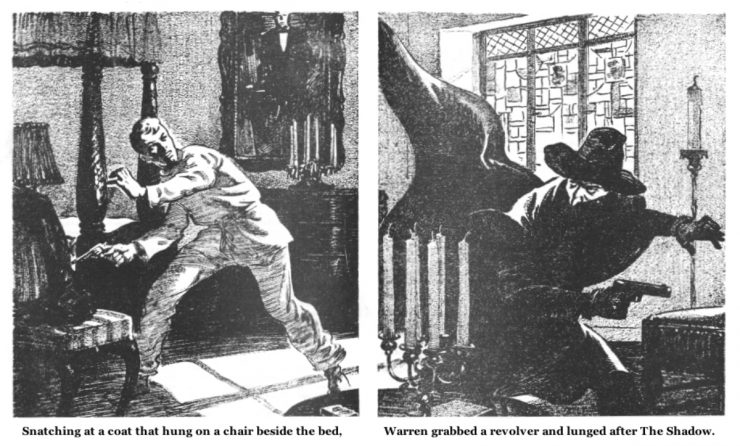Pulp magazines have influenced writers, artists, film directors, software developers, and countless others over the years. Our “PulpFest Historical” articles focus on the rough-paper writers, editors, publishers, and artists who have inspired and continue to inspire the creators of the world’s popular culture.
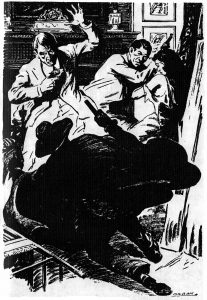
In the pulp world, only artists who dazzled fans seem to be remembered. J. Allen St. John used the dark palettes of Rembrandt and El Greco for his paintings, employed the looser techniques of Impressionists like Degas and early Cezanne, and peopled his canvases with dashing heroes and heroines. While his dominant figures rarely displayed personality, the drama and sheer atmosphere in his work are unforgettable.
Hannes Bok’s singular “language” was unmistakable. His illustrations were seldom closely related to the story, yet they conveyed a feeling that heightened one’s appreciation. Bok’s illustrations were actually decorations, transporting the viewer from the mundane into a world of the artist’s own making.
Although there were other artists who became legendary, it was often the “no-name” illustrators who “carried” each magazine month after month, like the great character actors who support the stars. These “no-name” artists were indispensable professionals.
In the illustration directly above, the two figures at the top grab our attention. Our eyes are drawn to the left crook’s white face as he desperately tries to pull his gun. His raised arm and open palm shift our focus to the white coat and face of the second crook. His angle directs our eyes to the girl. The curve of her body and the white diagonal on the right pull us to the foreboding image of The Shadow. His raised arm — mirroring the first crook’s — holds a weapon. The overturned chair parallels The Shadow and contains the action.
This black and white illustration is a complex, but very successful treatment for a difficult scene. The artist is Paul Orban.
Born June 23, 1896, in Budapest, Paul Orban emigrated to the United States in 1902. At the age of fourteen, Orban was paid five dollars for two weeks’ work on a watercolor. According to a friend of the artist, “He decided such easy money was for him!”
Orban studied at the Chicago Academy of Fine Arts. While yet a student, he began working as a staff artist for THE CHICAGO TRIBUNE. Some of his first published assignments were illustrating Sax Rohmer’s Fu Manchu serials, inspiring the young artist to develop a talent for graphic melodrama.
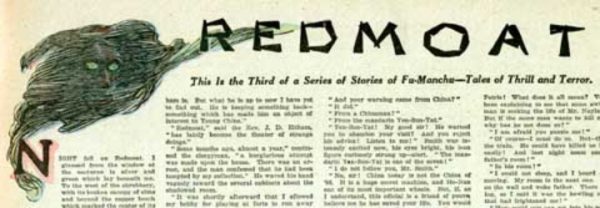
Following his stint at the TRIBUNE, Orban worked his way up to become the art director 0f an advertising agency. This position, however, may have been lacking in either challenge or sufficient returns for Orban’s needs — perhaps both. The artist moved to New York and took up freelance illustrating.
During the 1930s, pulps demanded more than just fast work on short deadlines for illustrators. Art directors expected an artist to use the right style to convey mood — perhaps character — to a story that would be printed on rather porous paper. To some extent, the method of reproduction often dictated the means whereby illustrations could be done.
Orban’s earliest known pulp work appeared in the January 1931 issue of THE GOLDEN BOOK MAGAZINE, illustrating a W. Somerset Maugham reprint. His work can also be found in THE BLUE BOOK MAGAZINE from the same period.
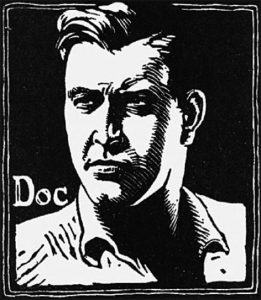 By 1933, Paul Orban was working for Street & Smith, creating the interior art for DOC SAVAGE MAGAZINE, a magazine he would illustrate uninterrupted from its first number to its final issue in 1949.
By 1933, Paul Orban was working for Street & Smith, creating the interior art for DOC SAVAGE MAGAZINE, a magazine he would illustrate uninterrupted from its first number to its final issue in 1949.
Except those from Popular Publications, Orban worked on just about all of the major hero pulps during a long pulp career. THE AVENGER, CAPTAIN FUTURE, THE PHANTOM DETECTIVE, THE SHADOW, THE SKIPPER, THE WHISPERER, and others all made extensive use of his services.
But Paul Orban was no one-trick pony. His art crossed genres, appearing in pulps as diverse as ASTOUNDING, CLUES, DETECTIVE NOVELS, EXCITING WESTERN, HORROR STORIES, POPULAR DETECTIVE, POPULAR BASEBALL, RIO KID WESTERN, RODEO ROMANCES, SKY FIGHTERS, SPACE SCIENCE FICTION, STRANGE STORIES, STARTLING STORIES, TERROR TALES, TEXAS RANGERS, THRILLING LOVE, THRILLING MYSTERY, THRILLING SPORTS, TOP-NOTCH, TRIPLE WESTERN, UNKNOWN, and WESTERN STORY MAGAZINE.
Best remembered for his work on DOC SAVAGE and THE SHADOW, Paul Orban also had a long association with Street & Smith’s ASTOUNDING. Although his first known illustrations for ASTOUNDING STORIES appeared in 1933 and 1934, he did not begin to contribute consistently to the magazine until late 1938.
Retitled ASTOUNDING SCIENCE-FICTION and edited by John W. Campbell, Orban’s work was initially undervalued by science fiction fans. However, by the April 1939 issue, the artist’s shrewd sense for composition graced Jack Williamson’s “One Against the Legion.” At year’s end, his strong black and white work for A. E. Van Vogt’s “Discord in Scarlet” rivaled the popular Charles Schneeman’s expertise. By the late 1940s, Orban’s scratchboard illustrations for ASTOUNDING were on par with Lawrence’s and Finlay’s work.
It is ironic to note that the relatively forgotten Paul Orban illustrated the first magazine editions of many science fiction classics: Lester Del Rey’s “Nerves” and Lewis Padgett’s (Henry Kuttner and C. L. Moore) “The Twonky” (September 1942); Lawrence O’Donnell’s (again, Kuttner and Moore) “Clash by Night” (March 1943); Fritz Leiber’s “Destiny Times Three” (March – April 1945); Murray Leinster’s “First Contact” (May 1945); A. E. Van Vogt’s “World of Null-A” (August – October 1945); and Isaac Asimov’s “Foundation” story, “The Mule” (November – December 1945).
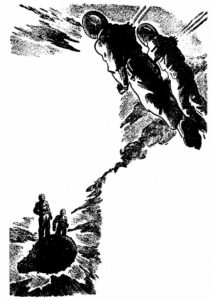 Other classics included Lewis Padgett’s “The Fairy Chessman” in 1946 and “Tomorrow and Tomorrow” in 1947, Lawrence O’Donnell’s “Fury” in the same year, and Theodore Sturgeon’s “Unite and Conquer” and Wilmar H. Shiras’ “In Hiding” in 1948. Orban also contributed the first of four ASTOUNDING covers — a painting for Poul Anderson’s “Genius”– to the December 1948 number.
Other classics included Lewis Padgett’s “The Fairy Chessman” in 1946 and “Tomorrow and Tomorrow” in 1947, Lawrence O’Donnell’s “Fury” in the same year, and Theodore Sturgeon’s “Unite and Conquer” and Wilmar H. Shiras’ “In Hiding” in 1948. Orban also contributed the first of four ASTOUNDING covers — a painting for Poul Anderson’s “Genius”– to the December 1948 number.
The above-mentioned stories are but a few of the milestones published in ASTOUNDING. Subsequent hardcover and mass-market paperback editions attest to their status in the science fiction genre.
Throughout the forties and fifties, Paul Orban continued a career that included work for the Hearst publications, READER’S DIGEST, THE NEW YORK TIMES, paperback covers, book covers for Winston juveniles, and illustrations for more than twenty science fiction magazines. When contacted in 1965 by Fred Cook — who had just begun publishing his pulp fanzine BRONZE SHADOWS — Orban reported that he was illustrating educational film strips and high school and college textbooks.
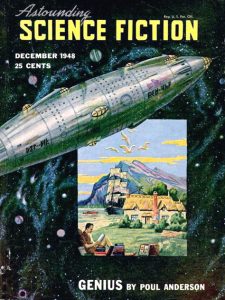 Take a second and third look at Paul Orban’s work in whatever pulp you may have. Symbolic or illustrative, evocative or violent, he may come at you in the form of a spaceship or the darkness of The Shadow. He was, in a word, ASTOUNDING!
Take a second and third look at Paul Orban’s work in whatever pulp you may have. Symbolic or illustrative, evocative or violent, he may come at you in the form of a spaceship or the darkness of The Shadow. He was, in a word, ASTOUNDING!
In SCIENCE FICTION ART, Brian Aldiss writes:
“Paul Orban was an incurable romantic in a field of incurable romantics. Under the trappings of technology, he expressed more perennial things — unending quests, great aspirations, long farewells, and a welcoming pair of arms on the far side of light.”
Paul Orban traveled to that far side of light reserved for artists in April 1974. We salute him today on the 125th anniversary of his birth.
This is an abridged and updated version of Ray Capella’s “The Astounding Orban,” an article that ran in the eleventh issue — dated June 1999 — of Mike Chomko’s pulp fanzine, PURPLE PROSE. If you’re interested in reading Capella’s original, unabridged piece, Adventure House has one remaining copy of PURPLE PROSE #11 available for $10.
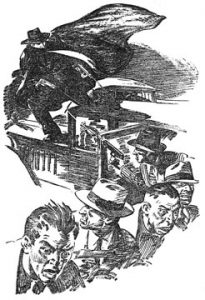 Paul Orban’s illustration for Theodore Tinsley’s Shadow novel, “Death’s Bright Finger” ran in the May 15, 1942 issue of Street & Smith’s THE SHADOW. His title bar for Sax Rohmer’s “Red Moat,” the “Third of a Series of Stories of Fu-Manchu — Tales of Thrill and Terror,” ran in the February 3, 1918 edition of THE SUNDAY CHICAGO TRIBUNE. It was one of five segments drawn from Rohmer’s “The Insidious Dr. Fu Manchu.” Orban’s portrait of Doc Savage appeared in many different issues of the Street & Smith hero pulp, while his illustration for Murray Leinster’s “First Contact” was one of several that ran in the May 1945 issue of the publisher’s ASTOUNDING SCIENCE FICTION. Paul Orban’s cover illustration for Poul Anderson’s “Genius” was featured on the December 1948 ASTOUNDING. It was one of four covers that Orban painted for the magazine. His illustration for Walter B. Gibson’s Shadow novel, “The Thunder King,” ran in the June 15, 1941 number of THE SHADOW. Note how the curled line of crooks leads the viewer to the imposing figure of The Shadow, towering high above the bad guys. Paul Orban’s illustration for Oliver Saari’s short story, “The Intruder,” ran in the April 1952 issue of STARTLING STORIES. It is a fine example of the artist’s later 1950s work. Last of all, our featured image ran in the September 1, 1942 issue of THE SHADOW, illustrating Walter B. Gibson’s Shadow novel, “The Vampire Murders.”
Paul Orban’s illustration for Theodore Tinsley’s Shadow novel, “Death’s Bright Finger” ran in the May 15, 1942 issue of Street & Smith’s THE SHADOW. His title bar for Sax Rohmer’s “Red Moat,” the “Third of a Series of Stories of Fu-Manchu — Tales of Thrill and Terror,” ran in the February 3, 1918 edition of THE SUNDAY CHICAGO TRIBUNE. It was one of five segments drawn from Rohmer’s “The Insidious Dr. Fu Manchu.” Orban’s portrait of Doc Savage appeared in many different issues of the Street & Smith hero pulp, while his illustration for Murray Leinster’s “First Contact” was one of several that ran in the May 1945 issue of the publisher’s ASTOUNDING SCIENCE FICTION. Paul Orban’s cover illustration for Poul Anderson’s “Genius” was featured on the December 1948 ASTOUNDING. It was one of four covers that Orban painted for the magazine. His illustration for Walter B. Gibson’s Shadow novel, “The Thunder King,” ran in the June 15, 1941 number of THE SHADOW. Note how the curled line of crooks leads the viewer to the imposing figure of The Shadow, towering high above the bad guys. Paul Orban’s illustration for Oliver Saari’s short story, “The Intruder,” ran in the April 1952 issue of STARTLING STORIES. It is a fine example of the artist’s later 1950s work. Last of all, our featured image ran in the September 1, 1942 issue of THE SHADOW, illustrating Walter B. Gibson’s Shadow novel, “The Vampire Murders.”
According to an interview with James Van Hise in SWORD & FANTASY #6, Raul Garcia-Capella was born in 1933 in Puerto Rico. While both of his parents were readers, his father was also a movie fan. Ray’s dad introduced him to serials, including Buster Crabbe’s Flash Gordon and the Nyoka serials, not to mention several Tarzan movies, westerns, and so on. By the time he was eight, Ray had read TARZAN OF THE APES and 20,000 LEAGUES UNDER THE SEA in Spanish.
A longtime member of the Los Angeles Science Fantasy Society, Ray was an accomplished writer and artist whose work appeared in AMRA, ECHOES, ERB-DOM, FANTASY BOOK, and other publications. His Arquel of Argos stories — action-driven sword & sorcery inspired by the work of Robert E. Howard, Leigh Brackett, A. Merritt, and Fritz Leiber — led to a book, THE LEOPARD OF POITAIN, published in 1985 by the Celt Press.
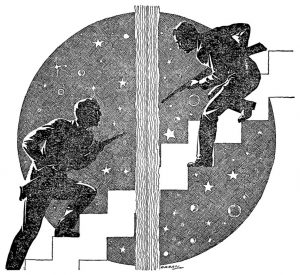 Ray died in June 2010.
Ray died in June 2010.
Michael Chomko, the winner of the 2010 Munsey Award, is the marketing and programming director for PulpFest. A registered nurse, Mike sells books on a part-time basis, operating as Mike Chomko, Books. His specialty is pulp-related material. Married for over forty years, he is the father of two adult children, as well as a recent grandfather.
From 1995 through 2003, Mike published seventeen issues of PURPLE PROSE. Write to him at mike@pulpfest.com about availability.

